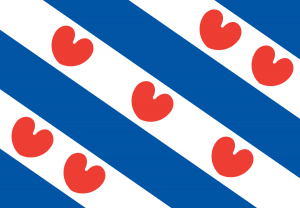Language/Western-frisian/Grammar/Gender
Hi Western Frisian learners! 😊
In this lesson, we will discuss the concept of gender in Western Frisian. As with many other languages, gender plays an important role in Western Frisian grammar, so it's crucial for learners to understand it well. We will introduce the concept of gender, explain how it works in Western Frisian, and provide some examples to illustrate it. So let's get started!
Introduction[edit | edit source]
Gender is a linguistic concept that refers to the classification of nouns into different categories based on their meaning, and sometimes their form. In Western Frisian, nouns are classified into one of two genders: masculine or feminine. Unlike some other languages, Western Frisian does not have a neuter gender. The gender of a noun affects the form of related words, such as articles, adjectives, and pronouns. Therefore, it's important to identify the gender of a noun in order to use the correct forms of related words.
Finish this lesson and explore these related pages: Descriptive Adjectives & Pronouns.
Masculine Gender[edit | edit source]
In Western Frisian, the masculine gender is used to classify nouns that refer to males, male animals, and other nouns that are considered masculine. The articles that are used with masculine nouns are "de" and "dy":
| Western Frisian | Pronunciation | English |
|---|---|---|
| de man | /də man/ | the man |
| dy houn | /diː ɦawn/ | the dog |
| de boer | /də bure/ | the farmer |
With adjectives, masculine nouns take the suffix "-e":
| Western Frisian | Pronunciation | English |
|---|---|---|
| de griene auto | /də ɣrinə auto/ | the green car |
| de sterke man | /də stɛrkə man/ | the strong man |
| dy swiere tas | /diː sʋirə tas/ | the heavy bag |
Pronouns that are used with masculine nouns include "hy" (he), "him" (him), and "syn" (his):
- Person 1: Hy is in man. (He is a man.)
- Person 2: Ik ken him net. (I don't know him.)
- Person 1: Syn auto stiet dêr. (His car is there.)
Feminine Gender[edit | edit source]
In Western Frisian, the feminine gender is used to classify nouns that refer to females, female animals, and other nouns that are considered feminine. The article that is used with feminine nouns is "de":
| Western Frisian | Pronunciation | English |
|---|---|---|
| de frou | /də frɔu/ | the woman |
| de kat | /də kat/ | the cat |
| de muoike | /də ˈmʉː.kə/ | the aunt |
With adjectives, feminine nouns take the suffix "-e":
| Western Frisian | Pronunciation | English |
|---|---|---|
| de read-wite bloem | /də rɛt.ˈʋi.tə bloːm/ | the red-white flower |
| de moaie frou | /də ˈmoːjə frɔu/ | the beautiful woman |
| de lytse kat | /də ˈləit.sə kat/ | the small cat |
Pronouns that are used with feminine nouns include "sy" (she), "har" (her), and "hare" (hers):
- Person 1: Sy is in frou. (She is a woman.)
- Person 2: Ik ken har net. (I don't know her.)
- Person 1: Hare auto stiet dêr. (Her car is there.)
Gender Exceptions[edit | edit source]
In Western Frisian, there are some nouns that do not follow the typical pattern of gender assignment based on biological sex. For example, some nouns that refer to inanimate objects are classified as masculine or feminine. This classification is usually based on the form of the noun, but it can also be influenced by its meaning. Here are some examples:
| Western Frisian | Pronunciation | English |
|---|---|---|
| de tafel | /də ˈtaːfəl/ | the table (feminine) |
| it boek | /ɪt buk/ | the book (neuter) |
| it skiep | /ɪt skiːp/ | the sheep (neuter) |
| de sleat | /də ˈsleːt/ | the ditch (masculine) |
As you can see, the genders of some nouns in Western Frisian cannot be deduced from their meaning or biological sex. Therefore, it's important to learn the gender of each noun individually.
Examples in Context[edit | edit source]
To better understand how gender works in Western Frisian, let's take a look at some examples in context.
- Person 1: Sjoch dêr! Dy griene auto is fan de boer. (Look there! That green car belongs to the farmer.)
- Person 2: Ha, de griene auto. Hy hat in moaie kleur. (Ah, the green car. It has a nice color.)
- Person 1: Ja, en syn auto hat ek in goede motor. (Yes, and his car also has a good engine.)
- Person 1: Fierderop sit in frou op in bankje. (Further down, a woman is sitting on a bench.)
- Person 2: Ja, ik sjoch har ek. Sy hat in hûntsje by har. (Yes, I see her too. She has a little dog with her.)
- Person 1: Ja, it is in lyts hûntsje, mar it is wol in moaie hûn. (Yes, it's a little dog, but it's a beautiful dog.)
Conclusion[edit | edit source]
In Western Frisian, gender is an important aspect of grammar. Nouns are classified into one of two genders, masculine or feminine, based on their meaning and sometimes their form. The gender of a noun affects the forms of related words, such as articles, adjectives, and pronouns. Therefore, it's important for learners of Western Frisian to pay attention to the gender of each noun and use the correct forms of related words.
To improve your Western Frisian Grammar, you can also use the Polyglot Club website. Find native speakers and ask them any questions!
➡ If you have any questions, please ask them in the comments section below.
➡ Feel free to edit this wiki page if you think it can be improved. 😎
Sources[edit | edit source]
Well done on mastering this lesson! Don't miss these related pages to expand your knowledge: Conditional Mood & Interjections.

